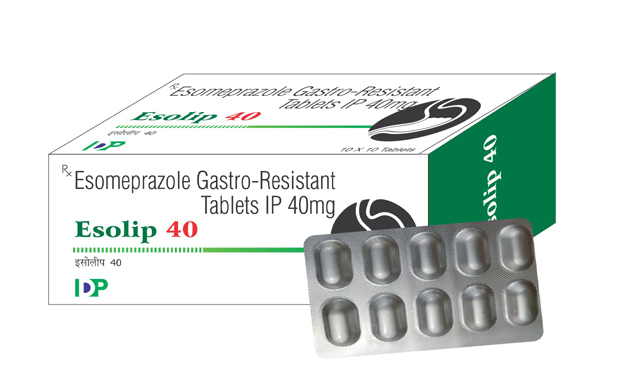Effectiveness is similar to other proton pump inhibitors (PPIs).[5] It is taken by mouth or injection into a vein.
Indications
Esomeprazole tablet is used in gastroesophageal reflux disease, treatment and maintenance of erosive esophagitis and duodenal ulcers caused by H. pylori, prevention of gastric ulcers in those on chronic NSAID therapy, and also treatment of gastrointestinal ulcers associated with Crohn's disease. It relieves symptoms such as heartburn, difficulty swallowing, and persistent cough. Used for the long-term treatment of pathological hypersecretory conditions including Zollinger-Ellison Syndrome.
Pharmacology
Mechanism of Action:
Esomeprazole exerts its stomach acid-suppressing effects by preventing the final step in gastric acid production by covalently binding to sulfhydryl groups of cysteines found on the (H+, K+)-ATPase enzyme at the secretory surface of gastric parietal cells. This effect leads to inhibition of both basal and stimulated gastric acid secretion, irrespective of the stimulus. As the binding of esomeprazole to the (H+, K+)-ATPase enzyme is irreversible and new enzyme needs to be expressed in order to resume acid secretion, esomeprazole's duration of antisecretory effect that persists longer than 24 hours.
Pharmacodynamics:
Esomeprazole inhibits gastric acid secretion and is indicated in the treatment of gastroesophageal reflux disease (GERD). Esomeprazole belongs to a new class of antisecretory compounds, the substituted benzimidazoles, that do not exhibit anticholinergic or H2 histamine antagonistic properties, but that suppress gastric acid secretion by specific inhibition of the H+/K+ ATPase at the secretory surface of the gastric parietal cell. By doing so, it inhibits acid secretion into the gsatric lumen. Esomeprazole is the s-isomer of Omeprazole, which is a racemate of the S- and R-enantiomer. Esomeprazole has been shown to inhibit acid secretion to a similar extent as Omeprazole. PPIs such as esomeprazole have shown to inhibit the activity of dimethylarginine dimethylaminohydrolase (DDAH), an enzyme necessary for cardiovascular health. DDAH inhibition causes a consequent accumulation of the nitric oxide synthase inhibitor asymmetric dimethylarginie (ADMA), which is thought to cause the association of PPIs with increased risk of cardiovascular events in patients with unstable coronary syndromes.
Pharmacokinetic:
Single 20 to 40 mg oral doses generally give rise to peak plasma esomeprazole concentrations of 0.5-1.0 mg/l within 1–4 hours, but after several days of once-daily administration, these levels may increase by about 50%. A 30-minute intravenous infusion of a similar dose usually produces peak plasma levels on the order of 1–3 mg/l. The drug is rapidly cleared from the body, largely by urinary excretion of pharmacologically inactive metabolites such as 5-hydroxymethylesomeprazole and 5-carboxyesomeprazole. Esomeprazole and its metabolites are analytically indistinguishable from omeprazole and the corresponding omeprazole metabolites unless chiral techniques are employed.
Following administration of equimolar doses, the S- and R-isomers are metabolized differently by the liver, resulting in higher plasma levels of the S- than of the R-isomer. Excretion The plasma elimination half-life of esomeprazole is approximately 1-1.5 hours. Less than 1% of parent drug is excreted in the urine.
Absorption: After oral administration, peak plasma levels (Cmax) occur at approximately 1.5 hours (Tmax). The Cmax increases proportionally when the dose is increased, and there is a three-fold increase in the area under the plasma concentration-time curve (AUC) from 20 to 40 mg. At repeated once-daily dosing with 40 mg, the systemic bioavailability is approximately 90% compared to 64% after a single dose of 40 mg.The AUC after administration of a single 40 mg dose of Esomeprazole is decreased by 43% to 53% after food intake compared to fasting conditions. Esomeprazole should be taken at least one hour before meals.The observed increase in esomeprazole exposure during co-administration with clarithromycin and amoxicillin is not expected to produce significant safety concerns.
Distribution: The apparent volume of distribution at steady state in healthy volunteers is approximately 16 L. Esomeprazole is 97% bound to plasma proteins. Plasma protein binding is constant over the concentration range of 2 to 20 µmol/L.
Metabolism: Esomeprazole is metabolized in the liver by the cytochrome P450 (CYP) enzyme system. The metabolites of esomeprazole lack antisecretory activity. The major part of esomeprazole’s metabolism is dependent upon the CYP2C19 isoenzyme, which forms the hydroxy and desmethyl metabolites. The remaining amount is dependent on CYP3A4 which forms the sulphone metabolite. CYP2C19 isoenzyme exhibits polymorphism in the metabolism of esomeprazole. At steady state, the ratio of AUC in Poor Metabolizers to AUC in the rest of the population is approximately 2. Nine major urinary metabolites have been detected. The two main metabolites have been identified as hydroxyesomeprazole and the corresponding carboxylic acid. Three major metabolites have been identified in plasma: the 5-O-desmethyl- and sulphone derivatives and hydroxyesomeprazole.
Elimination: The plasma elimination half-life of esomeprazole is approximately 1 to 1.5 hours. Less than 1% of parent drug is excreted in the urine. Approx 80% of an oral dose of esomeprazole is excreted as inactive metabolites in the urine, and the remainder is found as inactive metabolites in the feces.
Contraindications
It is contraindicated in patients with known hypersensitivity.Hypersensitivity reactions may include anaphylaxis, anaphylactic shock, angioedema, bronchospasm, acute interstitial nephritis, and urticarial.
Side Effects
● headache
● diarrhea
● nausea
● gas
● abdominal pain
● constipation
● dry mouth
● drowsiness
● allergic reactions, chest pain, dark urine, fast heartbeat
